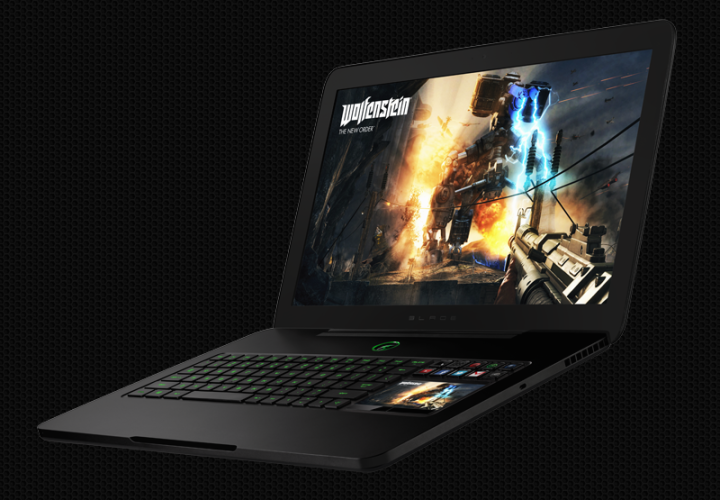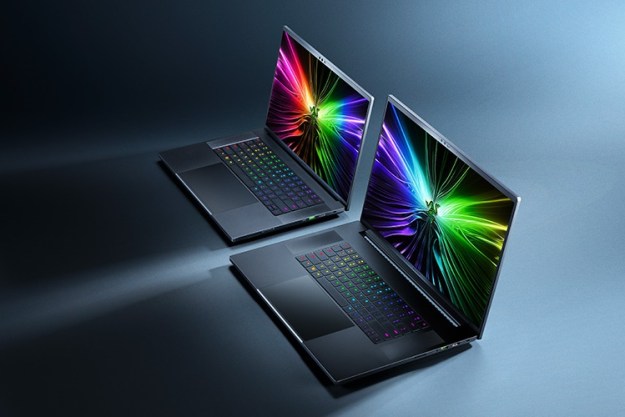
Razer, know for making high-end PC gaming gear, is doing everything they can to make you scream “TAKE MY MONEY NOW!,” if the announcement of their new Razer Blade and Razer Blade Pro notebooks are indication.
As you might expect from a company like Razer, neither the Razer Blade or the Razer Blade Pro compromise on specs or price. For instance, the Razer Blade Pro is powered by a 17.3-inch 1080p display, 4th gen Intel Core i7-4700HQ processor, Nvidia GeForce GTX 860M GPU, 16GB of RAM, an SSD that ranges between 128GB and 512GB, 802.11ac Wi-Fi and Bluetooth 4.0. The Blade Pro’s ports include a trio of USB 3.0, HDMI, Ethernet and a Kensington lock slot. Though it’s bulky at 6.54 pounds, the Razer Blade Pro is significantly lighter when compared with gaming notebooks released just two years ago.
Then there’s the Razer Blade (pictured below), a 14-inch powerhouse that sports a ridiculous 3200×1800 10-point touchscreen resolution display. Under the hood, you’ll find a 4th gen Intel Core i74702HQ CPU, 8GB of RAM, an SSD between 128GB and 512GB, and a brand new Nvidia GeForce GTX 870M GPU. With a body that measures just 0.7-inches thin, not only does Razer claim the title of “World’s Thinnest Gaming Laptop,” it’s also stacking a “World’s Highest Resolution 14-inch Laptop Display” crown on top of that. The Razer Pro also wields 802.11ac Wi-Fi, Bluetooth 4.0, along with, a trio of USB 3.0 ports as well as HDMI. Oh, and Razer claims that it 4.47 pounds; pretty light for a high-end gaming laptop.

Here’s the deal with the new Nvidia GeForce GTX 800M-series GPUs found in these new Razer notebooks: Aside from the company’s promises of improved performance when compared with previous-gen Nvidia mobile GPUs, the new 800M series chips also feature Battery Boost, GameStream and ShadowPlay.
Nvidia claims that Battery Boost will significantly improve the battery life of any notebook equipped with it. Battery Boost accomplishes this partly by allowing you to lock in a target frame rate. That way, your system doesn’t fluctuate between a range of frame rates, and eases the stress on your system’s components, which reduces power draw and conserves battery life. On top of that, Nvidia states that Battery Boost only supplies the required amount of power needed for optimal in-game performance.
The arrival of these new GeForce GTX 800M-series GPUs also bring with them two features that have already been present with desktop-based Nvidia graphics card; ShadowPlay and GameStream. ShadowPlay gives your notebook DVR-like functionality, allowing you to save at least the last 20 minutes of your gameplay, which makes sharing it with services like Twitch.tv easy. GameStream permits you to stream gameplay to devices like Nvidia’s own SHIELD.
In addition all that hardware, the Razer Blade Pro also comes with a ridiculous amount of extra software. It isn’t all stuff you’re going to immediately get rid of, either. For instance, Adobe Photoshop, Adobe Premiere Pro, Maya and GIMP all come pre-installed. So not only can you game on these rigs, but you can also create stuff too.
In both cases, the Razer Blade series seems like it will continue to set the standard for extremely powerful gaming laptops. The new Razer Blade and Blade Pro will also continue to carry very high price tags as well. The 14-inch Blade could cost you anywhere from $2,199 to $2,699. Meanwhile, the big, bad Razer Blade Pro starts at $2,299 and runs as high as $2,799.
Though both the Razer Blade Pro and the Razer Blade can be pre-ordered now, the former will begin shipping later this month, while the latter will start shipping out in early April. Click here to pre-order the Razer Blade. Click here to pre-order the Razer Blade Pro.
What do you think? Sound off in the comments below.
Editors' Recommendations
- This Razer gaming laptop with an RTX 4090 is $400 off for a limited time
- This Razer Blade 17 gaming laptop with an RTX 3070 Ti is 47% off
- The new ROG G14 completely upends the Razer Blade 14
- This Razer gaming laptop with an RTX 3070 Ti is $1,600 off
- I sat in Razer’s new gaming chair, and my back loved it


